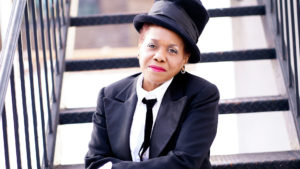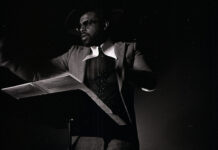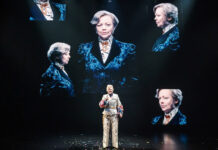
2004 was a pivotal year for singer Catherine Russell. As one of David Bowie’s regular back-up singers, she was accustomed to life on the road. When he stopped touring, she asked, “Now what?” With careful guidance, thoughtful consideration and an opportunity to use a recording studio in Chicago, she made the choice to record her first solo album.
Sixteen years later and with six more albums re-leased, she will be celebrating music old and new when she performs Saturday night at The Broad Stage in Santa Monica.
Russell sings jazz and blues and she loves to bring attention on her recordings to songs that aren’t well-known. Her most recent album, Alone Together, finds her singing such classic songs as I Only Have Eyes for You and Is You Is or Is You Ain’t My Baby. They are mixed with lesser known songs like He May Be Your Dog But He’s Wearing My Collar and When Did You Leave Heaven.
Last week I spoke by phone with Russell about life not just as a singer, but as a bandleader. Here are edited excerpts from that conversation.
When you look back to the decision you made in 2004, do you now wonder what took so long?
I had and have a very good career as a backup singer and worked with wonderful singers, but it was the right time. I was not looking to be a solo artist and bandleader. But I was convinced that was the thing that I had not done.
What have you learned that’s been most important to you about who you are as a singer in those 16 years?
It’s a combination of things. The singing part is not separate from the growth as a bandleader and being comfortable on the stage and making the transition to the center of attention and having my name on the ticket. It’s a combination of what that role entails. It’s not just singing. It’s really personal growth into the role.
What’s been the hardest part of that transition?
I didn’t see myself in that role. That isn’t what I had imagined – making all the decisions, running the band. When you are the leader, everything is up to me: how I run the show, how I put it together, the length of the show, the material, the flow, how I will talk to the audience telling them about the tunes. That’s all up to me.
When you do an album or a concert with songs sung by other artists for years, now do you approach those songs without letting the history of previous performances hang over you?
It is the story you are telling. The lyric speaks for itself. If the song is well-written, that speaks for itself. You keep the song alive by expressing yourself through it. A lot of the songs I pick are not as well known as others. There will be 50-60% of the show where people will tell me they’ve never heard the song before. I mix it up.
He May Be Your Dog… is a song recorded by Rosa Henderson. What stood out to you about these lyrics that made you say, “That’s a song I have to record?”
I like funny material. I like the material of early blues women. That’s a category I look into because the songs are well-written. It adds some levity to the show. The early blues tunes are picked for those purposes. To lighten up the vibe. Just like life we don’t stay in one mood. We like to react to different things.
Bettye LaVette told me that Billy Strayhorn’s Lush Life is a song that required more work than any other song. What are the songs that challenge you in equally profound ways?
Well Lush Life is one that I don’t include because it is a very dense serious tune. I’ll pick something like Abbey Lincoln recorded a song called No More. She recorded that on her first album. There are songs written in the 1950s I’ll include because they are harmonically complex. It takes your ear on a journey with different chord changes. I like to challenge myself that way.
Billie Holiday once said, “I hate straight singing. I have to change a tune to my own way of doing it. That’s all I know.” Do you agree with her and is there any other way to sing?
She may be referring to molding a melody to how she wanted it because she had a way of, if you want to know what the melody of the tune is, often times she is not going to be doing that. I think she was absolutely groundbreaking in how she molded a melody to her liking and to her phrasing. That I think may be what she’s talking about.
I have to, of course, when I’m learning a song, find my own rhythm and my own way of expressing it. But I do like to know what the melody is and then see how I want to work with it as the song progresses.
In January there was a post on your Facebook account discussing a week where you sang Bowie at The Cutting Room, sang with a vocal trio and then participated in Jazz Congress 2020. How important is it for you as an artist not to be pigeon-holed as doing just one thing?
People can pigeon-hole me if they like, but I like doing things I enjoy doing. It’s fun to rock out and I was a big fan of David Bowie’s music long before I worked with him. I love the fact that we are still paying tribute to David Bowie and I’m doing it with people who worked with him.
I like rock’n’ roll, I like classic rock as much as jazz, blues, classic country, classical music. You may find me in very opposing musical situations. Of course, I have to make a living and jazz is a great way to do that for me. I love the music and the musicians I work with. I’m glad that’s the category I’m in. I love jazz.
Photos of Catherine Russell courtesy of the artist.










